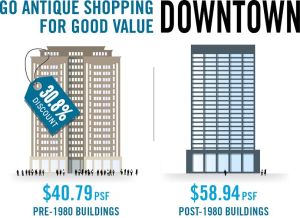 Like a fine wine, older Downtown Manhattan buildings are getting better with age—or at the very least, they are getting a lot more attention. With a total inventory of more than 89 million square feet, what happens when you look at the market by building age? Well, analyzing the market based on buildings built pre- and post-1980 uncovered some interesting results.
Like a fine wine, older Downtown Manhattan buildings are getting better with age—or at the very least, they are getting a lot more attention. With a total inventory of more than 89 million square feet, what happens when you look at the market by building age? Well, analyzing the market based on buildings built pre- and post-1980 uncovered some interesting results.
The market is much tighter for pre-1980 buildings, as the availability rate is 10.3 percent, compared to 19.8 percent for the newer inventory built after 1980. One reason for this could be that tenants continue to be priced out of Midtown and Midtown South and are looking for more cost-efficient space. In previous cycles, Midtown South and Downtown Manhattan were value options, but with the high demand and pricing in Midtown South, Downtown Manhattan has become the lone salvation for tenants. And many tenants have found these value options in older Downtown buildings.
In fact, average asking rents in Downtown Manhattan office buildings built prior to 1980 are more attractive at $40.79 per square foot, a 30.8 percent discount compared to the more modern buildings. At $58.94 per square foot, Downtown Manhattan buildings built after 1980 are averaging almost $4.00 per square foot higher than Class A buildings.
The hunt for value-driven tenants has amplified the migration of tenants from Midtown and Midtown South as well. In 2013, the total square footage leased by tenants relocating from north of Canal Street to Downtown Manhattan increased by 119 percent compared to 2012. Tenants relocating from Midtown leased more than 1.4 million square feet downtown, a 130 percent increase from 2012, while Midtown South tenants leased just over 900,000 square feet, a 94 percent increase.
And there are no signs of this trend slowing, as 2014 has already started off strong with more than 250,000 square feet in relocations transacted. Add in the completion of 1 World Trade Center, and the availability rate for post-1980 buildings will grow, but that is not necessarily a bad thing—sometimes, a stat is just a stat.


